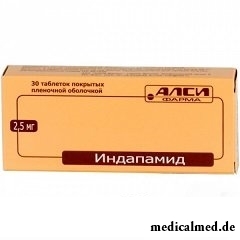





Indapamid
Application instruction:
 Indapamid – drug with vazodilatiruyushchy, hypotensive and diuretic action.
Indapamid – drug with vazodilatiruyushchy, hypotensive and diuretic action.
Form of release and structure
Indapamid release in the following dosage forms:
- Capsules (on 5 pieces in blister strip packagings, on 4 packagings in a cardboard pack; on 6 pieces in blister strip packagings, on 5 packagings in a cardboard pack; on 7 pieces in blister strip packagings, on 2 packagings in a cardboard pack; on 10 pieces in blister strip packagings, on 1-5 packagings in a cardboard pack; on 30 pieces in blister strip packagings, on 1-4 packagings in a cardboard pack; on 10, 20, 30, 40, 50, 100 pieces in banks, after 1 bank in a cardboard pack);
- Tablets of the prolonged action, film coated (on 10 pieces in blisters, on 2, 3, 6 blisters in a cardboard pack; on 30 pieces in banks, after 1 bank in a cardboard pack);
- Tablets with the modified release, coated (on 10 and 14 pieces in blister strip packagings, on 1, 2, 3, 100, 200, 300, 400, 500 packagings in a cardboard pack);
- Tablets, coated (on 20, 30 pieces in polyethylene bottles or banks, on 1 bottle or bank in a cardboard pack; on 10, 20, 30 pieces in blister strip packagings, on 1-6, 8, 10, 20, 40, 60, 80, 100 packagings in a cardboard pack; on 10 pieces in polymeric containers, on 1, 10, 20, 30, 40, 50, 100 containers in a cardboard pack; on 20, 30, 40, 50 pieces in polymeric containers, on 1, 10, 20 containers in a cardboard box);
- Tablets, film coated (on 10, 20 pieces in blisters, on 1-5 blisters in a cardboard pack; on 30, 50 pieces in blister strip packagings, on 1-3 packagings in a cardboard pack; on 10, 20, 25, 30, 50, 500, 1000 pieces in a polyethylene bottle, on 1 bottle in a cardboard pack).
Active agent – индапамид is a part of drug:
- Tablets of the prolonged action and tablet with the modified release, coated – 1,5 mg;
- Capsules, tablets, coated, and tablets, film coated – 2,5 mg.
Auxiliary components:
- Capsules: microcrystallic cellulose, magnesium stearate;
- Tablets of the prolonged action, film coated: monohydrate of lactose, gipromelloz, magnesium stearate, anhydrous colloid silicon dioxide;
- Tablets, coated: polyethyleneglycol, monohydrate of lactose (Toure 312), monohydrate of lactose (Spray-Dried), microcrystallic cellulose, magnesium stearate, croscarmellose sodium;
- Tablets, film coated: monohydrate of lactose, K30 povidone, кросповидон, magnesium stearate, sodium lauryl sulfate, talc.
Indications to use
Indapamid appoint for treatment of arterial hypertension.
Contraindications
- Heavy renal failure (in an anury stage);
- The expressed liver failure (including with encephalopathy);
- Galactosemia;
- Hypopotassemia;
- Syndrome of disturbance of absorption of a glucose/galactose, lactose intolerance;
- Concomitant use with the drugs extending QT interval;
- Pregnancy and period of a lactation;
- Age up to 18 years (safety and efficiency of use of drug for this age group of patients are not established);
- Hypersensitivity to drug components, and also to other derivatives of sulfonamide.
Indapamid patients should take with caution with functional disturbances of kidneys and/or a liver, a diabetes mellitus in a decompensation stage, a hyperuricemia (especially, followed uratny nephrolithiasis and gout), disturbances of water and electrolytic balance, a hyperparathyreosis, with the increased QT interval on an ECG or receiving other antiarrhytmic drugs.
Route of administration and dosage
Indapamid accept inside, once, in the morning, without chewing and washing down with liquid in enough.
Daily dose of drug – 1 tablet (in the form of tablets of the prolonged action and tablets with the modified release, coated – 1,5 mg; capsules, tablets, coated, and tablets, film coated – 2,5 mg). If in 1-2 months of therapy the desirable therapeutic effect is not reached, Indapamid's dose is not recommended to be increased (because of increase of risk of development of side effects without strengthening of anti-hypertensive effect). In these cases it is necessary to include other anti-hypertensive medicine which is not diuretic in the scheme of drug treatment. At reception of two various drugs, Indapamid's dose should not be adjusted (1 tablet a day, once, in the morning).
Side effects
During Indapamid's reception development of disturbances from some systems of an organism is possible:
- Cardiovascular system: orthostatic hypotension, arrhythmia, changes on an ECG (hypopotassemia), heartbeat;
- Central nervous system: nervousness, adynamy, headache, drowsiness, dizziness, sleeplessness, вертиго, depression; seldom – an indisposition, the general weakness, increased fatigue, a spasm of muscles, irritability, tension, alarm;
- Alimentary system: an abdominal pain, nausea, dryness in a mouth, anorexia, vomiting, a gastralgia, diarrhea, a lock, development of hepatic encephalopathy is possible; seldom – pancreatitis;
- Urinary system: nocturia, frequent infections, polyuria;
- Respiratory system: sinusitis, pharyngitis, cough; seldom – rhinitis;
- System of a hemopoiesis: very seldom – a leukopenia, thrombocytopenia, an agranulocytosis, hemolitic anemia and an aplasia of marrow;
- Laboratory indicators: a hypercalcemia, a hyperuricemia, a hypopotassemia, a hyperglycemia, a hyponatremia, a hypochloraemia, increase in an urea nitrogen in a blood plasma, a glucosuria, a giperkreatininemiya;
- Allergic reactions: hemorrhagic vasculitis, small tortoiseshell, rash, itch;
- Others: aggravation of a current of a system lupus erythematosus.
Special instructions
The elderly patients and patients accepting purgatives and cardiac glycosides against the background of a hyper aldosteronism need to control the maintenance of potassium ions and creatinine regularly.
During therapy it is necessary to control systematically concentration of ions of sodium, magnesium and potassium in a blood plasma (because of possible electrolytic disturbances), рН, concentration of glucose, residual nitrogen and uric acid. The first research of potassium concentration in blood is conducted during the first 7 days of treatment.
Also patients with the increased QT interval on the ECG (which developed against the background of any pathological process or inborn) treat group of the increased risk.
Patients with cirrhosis (especially with ascites or hypostases that is connected with risk of development of the metabolic alkalosis increasing expressiveness of hepatic encephalopathy), heart failure, coronary heart disease, and also patients of advanced age need the most careful control.
The hypercalcemia which developed in time of use of Indapamid can demonstrate existence of the hyperparathyreosis which is not diagnosed earlier.
It is necessary to control glucose level in blood at patients with a diabetes mellitus, especially at a hypopotassemia.
Considerable dehydration can lead to developing of an acute renal failure (decrease in glomerular filtering). Patients should offset loss of water and at the beginning of therapy carefully to control function of kidneys.
When carrying out a drug test Indapamid can yield a positive take.
At the arterial hypertension and a hyponatremia (connected with reception of diuretics) it is necessary in 3 days prior to reception of inhibitors of an angiotensin-converting enzyme to interrupt reception of diuretics (in case of need a bit later reception of diuretics can be resumed), or to appoint initial inhibitors of an angiotensin-converting enzyme in low doses.
Derivatives of sulfonamides can cause an aggravation of a current of a system lupus erythematosus (it is necessary to consider at Indapamid's appointment).
In some cases during therapy individual reactions which are connected with change of arterial pressure, especially at the beginning of therapy and at addition of other anti-hypertensive drug are possible. Because of it ability to driving and performance of the works requiring special attention can go down.
Medicinal interaction
At simultaneous use of Indapamid with some medicines there can be undesirable effects:
- Saluretics, purgatives, cardiac glycosides, тетракозактид, glyuko-and mineralokortikoida, Amphotericinum In (intravenously): increase in risk of development of a hypopotassemia;
- Cardiac glycosides: increase in probability of development of digitalis intoxication;
- Erythromycin (intravenously), астемизол, pentamidine, Vincaminum, терфенадин, сультоприд, antiarrhytmic means of I A classes (Disopyramidum, quinidine) and III class (bretylium tosylate, Amiodaronum, соталол): development of arrhythmia in the pirouette type (torsades de pointes);
- Non-steroidal anti-inflammatory drugs, тетракозактид, glucocorticosteroids, sympathomimetics: decrease in hypotensive effect;
- Calcium drugs: increase in probability of development of a hypercalcemia;
- Neuroleptics and imipraminovy (tricyclic) antidepressants: strengthening of hypotensive action and increase in risk of development of orthostatic hypotension;
- Cyclosporine: increase in risk of development of a giperkreatininemiya;
- Metforminum: increase in probability of aggravation of lactic acidosis;
- Inhibitors of an angiotensin-converting enzyme: increase in risk of development of an acute renal failure and/or arterial hypotension (especially at the available renal artery stenosis);
- Iodinated contrast means in high doses: increase in risk of development of renal failures (organism dehydration is possible, before use of iodinated substances by the patient it is necessary to recover liquid loss);
- Baclofenum: strengthening of hypotensive effect;
- Kaliysberegayushchy diuretics: development hyper - or hypopotassemias, especially at patients with a renal failure and a diabetes mellitus (some category of patients can have effective such combination);
- Indirect anticoagulants (derivatives of an indandion or coumarin): decrease in their effect (dose adjustment can be required);
- Not depolarizing muscle relaxants: strengthening of blockade of the neuromuscular transmission developing under their action.
Indapamid increases concentration in a blood plasma of ions of lithium (decrease in removal with urine), lithium has nephrotoxic effect.
Terms and storage conditions
To store in dry, protected from light, the place, unavailable to children.
Period of validity:
- Capsules, tablets of the prolonged action, film coated, tablets with the modified release, coated – 2 years at a temperature up to 25 °C;
- Tablets, coated – 3 years at a temperature of 15-30 °C;
- Tablets, film coated – 4 years at a temperature of 15-25 °C.
Name of drug
Price
Drugstore
Indapamid тбл п/пл/о 2.5mg No. 30, Hemofarm A.D. Ltd company (Serbia)/Hemofarm
80 rub.
 Network of the Moscow drugstores of IFC
Network of the Moscow drugstores of IFCIndapamid of MV of Stada ретард тбл п/пл/о 1,5mg No. 30, LLC Hemofarm
95 rub.
 Network of the Moscow drugstores of IFC
Network of the Moscow drugstores of IFCWhen lovers kiss, each of them loses 6,4 calories a minute, but at the same time they exchange nearly 300 species of various bacteria.

Dogrose – one of the most widespread adornment and medicinal plants growing practically in all territory ours...
Section: Articles about health
According to World Health Organization, every third inhabitant of Earth has excess weight, and every tenth has obesity. The reason of this phenomenon, according to specialists, roots in one not very comforting fact: most of people consume much...
Section: Articles about health
An eye of the person daily experiences considerable strain. The problem of preservation of sight is for many years directly connected with a question of supply of tissues of eye enough oxygen and nutrients. This task is carried out by small vessels – capillaries. For normal functioning of the visual device extremely important that they kept the integrity, but it works well not always. Microtraumas of eye vessels during which there are small hemorrhages it is extraordinary расп...
Section: Articles about health
Household skills which to us so diligently imparted in the childhood it appears, not always bring only benefit. According to result...
Section: Articles about health
Neurosis is called pathology of a nervous system at which deviations in functioning of the highest nervous processes are observed. Most often - owing to yet not strengthened mentality - children are subject to neurosises. Premises to emergence of such disturbances can become нез...
Section: Articles about health
For the person who daily since morning gathers for work it is very important to wake up vigorous and ready by day of work. Actually, each of us experiences difficulties with this, at first sight, simple business from time to time. After night rest exert impact on a condition of an organism the weather which collected for several days fatigue, household and office problems, quality of a dream and many other factors....
Section: Articles about health
No, probably, the person who would not have cold. Cold, cough, a headache – these symptoms are known to everyone. Peak to Prost...
Section: Articles about health
History of use of an anesthesia during operations contains more than 160 years. Annually in the world hundreds of thousands of surgical interventions during which to patients the substances immersing them in a dream and saving from pain are entered are carried out. Using an anesthesia to these...
Section: Articles about health
The words "disease" and "patient" not without reason come from one root – "pain". As a rule, symptoms of illnesses thoroughly spoil to patients life. However from this rule there are exceptions. Some diseases are shown by signs which can cause even positive emotions. It is a pity only that the majority of such illnesses are heavy and incurable....
Section: Articles about health
For the time being the perspective of heart diseases seems to most of people remote and foggy. But sooner or later практичес...
Section: Articles about health
About 20% of the population of our planet have a hypertension (permanent increase in arterial pressure). This disease has an adverse effect on the standard of living, reduces working capacity, and in the absence of systematic treatment threatens with such complications as a heart attack...
Section: Articles about health
The mankind knows that some toxins at intake in the minimum quantities have therapeutic effect from an extreme antiquity. Many substances recognized poisonous are applied in the medical purposes also today, being the main operating components of the medicines which are officially produced by pharmaceutical industry. Let's tell only about the most known of them....
Section: Articles about health
The kid who was recently born is surrounded with love of adult family members and their cares without which the baby cannot exist....
Section: Articles about health
Heart disease and blood vessels lead to disturbance of blood supply of bodies and fabrics that involves failures in their work, deterioration in health of the person, decrease in its working capacity and standard of living. Annually such perishes from pathologies more...
Section: Articles about health
Bathing in broths of medical flowers and plants (phytobathtub) was eurysynusic since Cleopatra who is a good judge in all that concerns beauty and health. And today phytobathtubs is the simple and available means allowing not only to remove nervous tension, but also to recover from many diseases. Grass bathtubs at treatment of cold, osteochondrosis, radiculitis, skin diseases, and also diseases of urinary tract and vessels are especially effective....
Section: Articles about health
The pancreas performs two functions in a human body: release of enzymes without which digestion carbohydrate is impossible...
Section: Articles about health
Popular joke that there are no healthy people, and is nedoobsledovanny, most of us considers an honest truth, continually it is necessary to hear that all of us are sick hardly from a school bench. It is hard to say, whether so it actually because...
Section: Articles about health
The metabolism at each person proceeds in own way. However between the speed of this process and disposal of excess weight after all all have a dependence. Unfortunately, the people inclined to try on itself numerous "miracle" diets, not always consider this circumstance and with the most resolute intentions begin to eat so that artificially slow down the metabolism instead of to accelerate it. Except quite clear disappointment, incorrectly picked up systems...
Section: Articles about health
The fatigue, sleep debt, disturbances of food, bad mood, vagaries of the weather – all these circumstances badly are reflected in our vn...
Section: Articles about health
Cold, puffiness of a nose, itch, the watering eyes - characteristic symptoms of the allergic rhinitis resulting from hit of allergens (pollen, house dust, hair of animals, etc.) on a mucous membrane of a nose. Unpleasant feelings often deliver беспоко...
Section: Articles about health
Stroke (acute disorder of cerebral circulation) – one of the most widespread neurologic diseases. Annually in the world more than 6 million people die of this illness. From the survived patients about 80% become disabled people, and nearly a third from them needs afterwards permanent care. In fact, the stroke creates a situation at which a part of cells of a brain loses blood access, loses an opportunity to receive oxygen and nutrients, and perishes. As a result of a razviv...
Section: Articles about health
For many women the word "fat" sounds as a sentence. In aspiration to an ideal figure they try to exclude, first of all, from with...
Section: Articles about health
Almost each of us during life faced dissatisfaction with own body. At such moments, as a rule, we begin to shame ourselves, urgently we go on the most rigid diet promising minus of 10 kg in a week, or we exhaust ourselves in the gym to полусм...
Section: Articles about health
EKO, or extracorporal fertilization - a method of treatment of infertility which became the reason of a set of broken-down copies in due time accused the people working on its creation neither more nor less of rivalry good luck. Already very few people deny the right of a method for existence, and to surprise nobody with "children from a test tube". And nevertheless, a certain magic in the procedure of artificial fertilization is, process of origin of new life is always a secret, and even it р now...
Section: Articles about health
Is told about advantage of domestic animals for development of the child much. But many parents nevertheless do not hurry to bring pets as about...
Section: Articles about health
Life of the modern woman is very difficult. Opportunities to realize itself are wide: it not only education and career, but also the most various hobbies from sport before needlework. It is not less important to build private life, paying an attention maximum to children, the husband, parents, e...
Section: Articles about health
Traveling all over the world, many try to try the most exotic dishes of national cuisines. There is even a so-called gastronomic tourism which, according to gourmets, not only allows to receive new feelings, but also is capable to show life of other people from absolutely unexpected side....
Section: Articles about health

